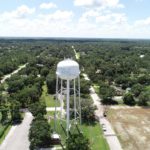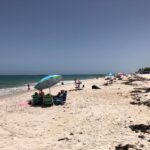VERO BEACH – Anyone passing Al Worden’s Vero Beach home wouldn’t know who lives there from the man on the moon.
But when the garage door is up, he might as well be sitting atop a Saturn rocket at Cape Canaveral.
His parked pewter Porsche bears a telltale license plate: Apolo15.
Worden is one of only 24 people on the planet who actually went to the moon 40 years ago.
But he’s still scratching his head about the vanity plate.
“I don’t know why I got that license plate. Sometimes I wish I didn’t have it,” Worden says. “Especially when I’m in a hurry.”
Indeed, Worden is often in a hurry – he keeps an intense schedule of speaking engagements, and that will be escalating when his new autobiography, “Falling to Earth: An Apollo 15 Astronaut’s Journey to the Moon” is released by Random House in July.
It is the endless interruptions in parking lots, where the sight of him getting out of the car with that license tag triggers memories of the hero’s welcome the world gave to the Apollo astronauts returning from the moon.
That moment has defined his life.
Worden’s reentry into civilian life post-NASA was conjured up with one of his best friends, GM president Ed Cole, who was himself about to retire.
Cole was going to set up Worden with a Cadillac dealership in Florida. “We would drink Mai-Tais on the beach,” says Worden.
He was going back to school at Michigan’s Northwood University for a course in the automotive industry when Cole died in an airplane crash in 1975.
Meanwhile, Northwood invited Worden to stay on and teach. Eventually he came down to Florida to help raise funds for a campus here.
Worden and his wife, Jill, bought a place in Sea Oaks in 1989. By then, Worden was running a research firm with a Canadian partner and had invented and patented an aviation program.
For a boy whose mission in life was to get off the family farm, Worden certainly succeeded – by about 239,000 miles. Raised in Jackson, Mich., he ran the farm for his father, a “city boy” who left the milking, plowing and baling of hay to Al from the age of 12.
“It was a great motivating factor,” he laughs. “I had only one guiding principle – to get off the farm.” By high school, while not an athlete, he clearly showed leadership.
As student body president with good grades and a stack of honors including the American Legion award, he was sponsored by a local congressman to go to West Point.
There he starred not as a quarterback, but as a cheerleader; gymnastics was his sport.
It never crossed his mind to become an astronaut.
“There was no such thing as space,” he says.
Worden’s joke wasn’t far from the truth, at least in terms of man’s presence there.
President Dwight D. Eisenhower was ambivalent about manned flight. It wasn’t until Vice- President Lyndon Johnson reported back to President John F. Kennedy that he thought the Americans could beat the Soviet Union to the moon, that Kennedy funded the program that would ultimately carry Worden into lunar orbit and put 12 Americans on the moon’s surface.
In early 1961, a chimp was strapped in and launched from Cape Canaveral. In space, he pulled the lever only a fraction of a second more slowly than on earth, and returned suffering only a bump on the nose.
He was christened “Ham” – but only after NASA knew he had survived.
Fifty years later, it is Ham and other primates used in space that Al Worden is honoring with an appearance at the Save the Chimps benefit Feb. 26 at McKee Botanical Garden.
He will be joined by fellow astronauts Robert Crippen and Scott Carpenter.
The restored McKee Garden is celebrating its own 10-year anniversary, the same as the Save the Chimps sanctuary. McKee – a tourist attraction dating back to the 1920s, once featured its own chimpanzee pair – Napoleon and Josephine.
The two had more or less free reign over the park, and amused tourists by eating their meals with plates and forks.
McKee fell into disrepair until 10 years ago when the historic gardens were restored and reopened.
That year, the late University of Florida anthropologist Carole Noon rescued her first chimps, many originally from the space program, and eventually gave them new homes at her Save the Chimps Sanctuary in Fort Pierce. It is now the largest chimp sanctuary in the world.
Now, with the shuttle program ending, U.S.-sponsored manned flight is on indefinite hold.
“It was a pretty phenomenal program,” says Worden, speaking of Apollo. “We put six crews on the moon in a four-year period 40 years ago, and we haven’t been able to do it since.”
“The funding for the NASA program is ….miniscule. If you put that money into welfare programs, it wouldn’t do any good. But NASA is a political football in Washington. For politicians who are looking to tell the public, ‘We’re cutting where we can,’ it’s a big deal that we can cut $18 billion.”
It was on a July morning in 1971, that the then 39-year-old Worden blasted into space atop a gigantic Saturn 5 rocket, strapped in alongside David Scott and James Irwin.
They orbited the earth three times before soaring toward the moon and separating the lunar module with Scott and Irwin inside for its descent to the moon’s surface.
Meanwhile, Worden, as command module pilot, circled the moon 74 times, managing cameras and experiments.
Three times, he ventured out of the module, his spacesuit tethered to an umbilical cord containing oxygen and a stainless steel cable for radio transmission.
“I had trained too well,” he says. “I got the job done quicker than everybody thought. I couldn’t think of a good excuse to stay out there, so I had to come back.”
On his website, www.AlWorden.com, the TV and radio transmission from his space walk is played, at times sounding more like a stroll.
“Beautiful job, Al baby,” says a voice from Mission Control. “Remember there’s no hurry up there at all.”
“OK,” replies Worden. “I’m enjoying it.”
Today, he says that moment, when he could see the earth and the moon at the same time, was the most awe-inspiring of his trip in space.
“I could cover the earth with my thumb,” he says. “You look back, and you get this growing feeling that we’re destroying it, all these little factions fighting each other. We were still in the Cold War, and I thought, it would be nice to take the president of the U.S. and the leader of Russia and put them together in space, and leave them together for a couple of weeks to look back on the earth. That would solve their problems.”






